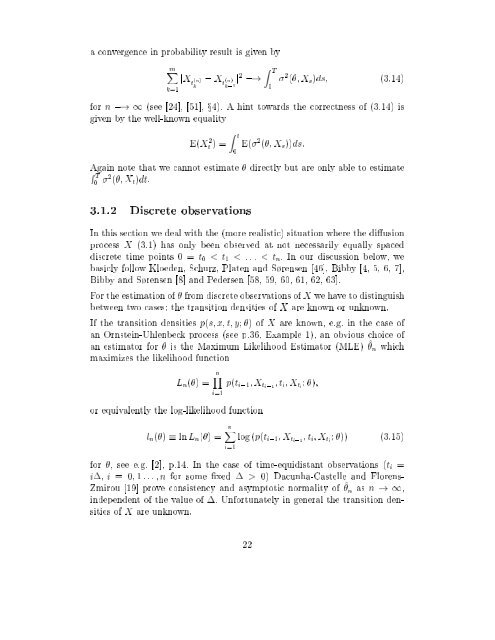Estimation in Financial Models - RiskLab
Estimation in Financial Models - RiskLab
Estimation in Financial Models - RiskLab
You also want an ePaper? Increase the reach of your titles
YUMPU automatically turns print PDFs into web optimized ePapers that Google loves.
a convergence <strong>in</strong> probability result is given by<br />
mX<br />
k=1<br />
jX t<br />
(n)<br />
k<br />
, X (n) t<br />
j 2 ,!<br />
k,1<br />
Z T<br />
0<br />
2 (; X s )ds; (3.14)<br />
for n ,! 1 (see [24], [51], x4). A h<strong>in</strong>t towards the correctness of (3.14) is<br />
given by the well-known equality<br />
E(X 2 t )=<br />
Z t<br />
0<br />
E( 2 (; X s ))ds:<br />
Aga<strong>in</strong><br />
R<br />
note that we cannot estimate directly but are only able to estimate<br />
T<br />
0<br />
2 (; X t )dt.<br />
3.1.2 Discrete observations<br />
In this section we deal with the (more realistic) situation where the diusion<br />
process X (3.1) has only been observed at not necessarily equally spaced<br />
discrete time po<strong>in</strong>ts 0 = t 0 < t 1 < ::: < t n . In our discussion below, we<br />
basicly follow Kloeden, Schurz, Platen and Srensen [46], Bibby [4, 5, 6, 7],<br />
Bibby and Srensen [8] and Pedersen [58, 59, 60, 61, 62, 63].<br />
For the estimation of from discrete observations of X wehave to dist<strong>in</strong>guish<br />
between two cases: the transition densities of X are known or unknown.<br />
If the transition densities p(s; x; t; y; ) of X are known, e.g. <strong>in</strong> the case of<br />
an Ornste<strong>in</strong>-Uhlenbeck process (see p.36, Example 1), an obvious choice of<br />
an estimator for is the Maximum Likelihood Estimator (MLE) ^ n which<br />
maximizes the likelihood function<br />
L n () =<br />
nY<br />
i=1<br />
or equivalently the log-likelihood function<br />
l n () ln L n () =<br />
p(t i,1 ;X ti,1 ;t i ;X ti ; );<br />
nX<br />
i=1<br />
log (p(t i,1 ;X ti,1 ;t i ;X ti ; )) (3.15)<br />
for , see e.g. [2], p.14. In the case of time-equidistant observations (t i =<br />
i; i = 0; 1 :::;n for some xed > 0) Dacunha-Castelle and Florens-<br />
Zmirou [19] prove consistency and asymptotic normality of ^ n as n ! 1,<br />
<strong>in</strong>dependent of the value of . Unfortunately <strong>in</strong> general the transition densities<br />
of X are unknown.<br />
22
















